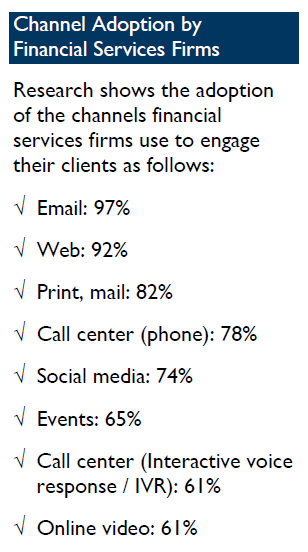Some seven years after the launch of Twitter we still hear reports of corporate America doing less than they could be to listen and respond to customers via social media. Even as research shows that companies are consciously trying to engage their customers on multiple channels. For example, a recent Aberdeen Group study reported that financial services firms are commonly using no fewer than eight channels to engage their customers, including social media, call centers (voice and interactive voice response), e-mail, websites, online video and more. Is it still too hard to integrate these channels to provide a superior customer experience?
It’s about to get easier as the cloud-based contact center evolves and adoption increases. In the United States, cloud-based call center technology, as used for inbound routing and queuing of live calls, enjoys a respectable, but plenty-of-room-to-grow 3.5 percent penetration rate. With the next generation of cloud-based contact center technology, customer experience should improve as penetration increases.
Here’s what I mean. Any state-of-the-art contact center platform supports multi-channel engagement across voice, online and social avenues and aims to treat them equally. For example, a web chat, for monitoring, audit, analysis, agent grading and historical reporting purposes should look just like a traditional voice call. Handling all channels on a common cloud platform provides a unified, 360-degree view of all customer interactions from a single vantage point. Early cloud call center offerings that relied on CRM integrations for multi-channel support are yielding to comprehensive solutions that support multi-channel natively.
Interestingly, it’s the migration of voice from on-premise TDM-based solutions to cloud-based VOIP platforms that are the key enabler. It’s difficult to impossible to backfill support for modern online channels to legacy TDM equipment. The television advertising industry realized a similar migration as video distribution migrated to Internet technologies, allowing the cross-application of online advertising precision targeting and measurement capabilities.
Cloud Contact Centers, Practically Speaking
So what does this new cloud contact center model look like, in practical terms? It means the ability for contact center agents to gracefully switch back and forth between online and voice channels. It’s the ability for an agent to easily escalate a web chat with a customer to live voice call. It means social media listening that ties positive or negative tweets or other social comments back to their contact center record, and alerts agents immediately, so they might respond to a voice call to a customer’s complaint on Twitter.
That same Aberdeen Group report noted that financial services firms struggle with the quality of their customer experience management data and that many have a hard time distinguishing more profitable clients from less profitable clients. These problems impact them in two ways: difficulty in improving the customer experience overall, beyond just individual transactions, and difficulty in monetizing the data, to be able to better target offers to higher-value clients.
This is where a unified platform in the contact center can help. When online and social customer engagement channels are handled just like traditional voice calls, data and reporting across all channels become standardized. It becomes easier to measure and improve key performance indicators. Standardized data is easier to merge with other business intelligence data, to be able to glean insights, and surface those higher-value clients.
A separate Aberdeen Group report this year that studied how 374 firms translated data into superior customer experiences found that the best-in-class performers enjoyed an 88% customer retention rate, an 18% average year-on-year improvement in customer satisfaction, and a 19% year-over-year improvement in annual company revenue. The vast majority of those performers – more than 80% - use customer relationship management, business intelligence and data quality/integration tools. Over half take advantage of real-time reporting and alerting. (At the bottom end, the laggards saw annual declines in revenue and customer satisfaction.)
Of course, customer relationship management takes place, and data originates, within the contact center. It is incumbent on contact center technology vendors to look downstream and consider how the data is being analyzed, and take every step possible to standardize it across customer engagement channels, format it so that it’s easily ingested by business intelligence and other analysis tools, and expose it for real-time analysis, alerting and searching. Those that do will be positioned to share in the rewards that Aberdeen Group reports.
Conclusion
Advanced cloud-based technology continues to be a key enabler for enterprises looking to improve the customer experience, and the bottom line. Ongoing studies show that top corporate performers, as measured by customer satisfaction and revenue growth begin at the contact center, and strive to unify their view of customer engagements across an increasing number of channels. Companies that are slow to suffer higher churn rates and face lower revenues, and decreased customer satisfaction. Contact center technologies that enable this unified, 360-degree view, and standardize data output, are emerging and enjoying increased adoption rates.

